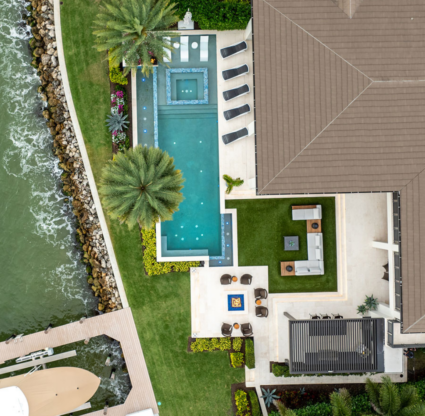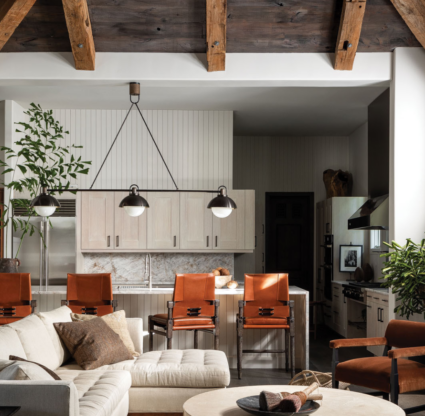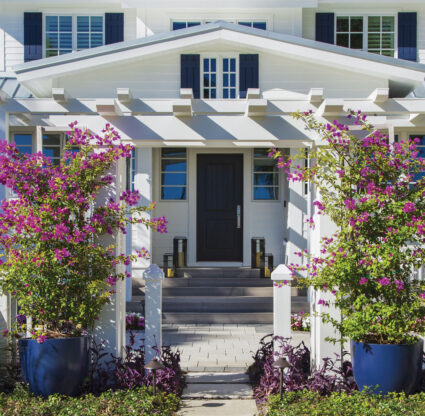There’s something fantastical about projects like Mexico City’s Museo Soumaya, Santiago Calatrava’s building at Florida Polytechnic University in Lakeland and the Walt Disney Concert Hall designed by Frank Gehry in Los Angeles. But even as these mind-boggling exteriors curve, warp and drape, they are very much of this earth, grounded in math and science.
Produced through a practice known as parametric design, these wonders of construction result from carefully integrated computational programs that use algorithms to define forms and structures based on given parameters.
The exact meaning of the word is contested, but when industry leaders talk about the next great style after modern and postmodern architecture, they’re referring to parametric design. Believers pose that parametric—which can be applied to everything from a piece of jewelry to furniture to a skyscraper—is defined by elegantly complex forms that are curvaceous, fluid and reminiscent of patterns found in nature. Nature’s hypnotic forms and systems have inspired architects since the dawn of design. In 1 B.C., Roman architect Marcus Vitruvius Pollio wrote De architectura, one of the earliest books on the topic. He noted the importance of finding the right combination of stability, utility and beauty in construction, and his work inspired acolytes to later create curving and domed structures like the Pantheon, buildings in the Roman Forum and triumphal arches.
By the 1900s, legendary Catalan architect Antoni Gaudí had made significant contributions to the curvaceous cause with several buildings you can still visit in Barcelona, including the Sagrada Família. While he didn’t use the word parametric, he spent 10 years crafting a hanging chain model with weighted strings to see how the natural arches would fall and how the structure was affected when a weight moved. Gaudí also applied biomimicry to his designs, wherein sustainable structures take on the characteristics of living things. “There are no straight lines or sharp corners in nature. Therefore, buildings must have no straight lines or sharp corners,” Gaudí proclaimed.
Today’s architects have the freedom to manipulate, animate and interact with entities, such as splines, NURBS and subdivisions, with the aid of fluid 3D models. Every variable is considered—wind direction, sun path, load calculations, geographical features—and helps alter the form, performance and perception of the building’s design.
You can consider parametric to be a natural evolution. While the Second Industrial Revolution—with its mass production, standardization and form-follows-function mentality—gave birth to modernism, the digitally enabled Fourth Industrial Revolution moves toward highly customizable, contextual and adaptive design. The decrease in time and resources spent, along with the computational enhancements, aids experimentation, allowing architects to shift paradigms and rethink the building process.
Paradoxically, in employing parametric, designers are often looking to the organic. Many parametric exercises aim to analyze and map out the complex physical forms and organizational systems found in nature and apply them to improve on the built world.
It’s tempting to focus only on large feats of construction—Gehry’s Guggenheim Bilbao Museum and the swooping facade of Heydar Aliyev Center in Baku by Zaha Hadid—but parametric is also seen in other areas. It can be something as contained as the wavy, latticed roof of the Kogod Courtyard at the National Portrait Gallery in Washington D.C. We see it in interiors, like Boston architect Steven Harris’ dramatically curved walls and stark white staircases that resemble an unfurled streamer. John Brevard in Ibiza designs parametric benches and chairs inspired by morphogenesis, the biological process that causes a tissue or organ to develop its shape. And, Antony Gibbon Designs creates a circular laser-cut aluminum Salt Table Series and sculptural Ilume lighting—in addition to his architectural and interior projects.
Here in Southwest Florida, it can be easy to dismiss the importance of loose design when you’re surrounded by boxy shopping centers, ranch homes and Mediterranean-inspired villas. But take in Miami’s One Thousand Museum residential tower by Zaha Hadid, and see if you’re unmoved by the waving wonder set along the waterfront. Even if the aesthetics don’t impress, the engineering should. A continuous frame resists the coastal wind loads and the curving diagonal bracketing is meant to abrade the intermittent hurricanes that befall the city. The structure alternately gets thicker and thinner, weaving a pattern to break the dull facade and permeate structural loads and breeze flow.
However it’s used, the very best of parametric design takes direction from its location, defies expectations, unlocks innovations and ultimately creates a moving experience.






